Session Notes: Translating UX Terms into a Business Context

— Principal designer at custom ink and I’m here to focus on translating terms into business context

— I create custom products to promote deep engagmeent with communities, and have seen how language plays key role in alignment with disciplines
-
Soft skills essential for a strong design voice

— Why is it important to speak a shared language?

— Per Jakob Nielsen, unstable terms has a huge cost overhead, and not knowing what something is called, or what a newly created word means

— For the product person, translation is key

— And to earn seat at the decision-making table, you need to grasp business language

— All quotes reflect need for a common language that can be used in all situation, in all business situations
-
Less esoteric language builds trust and understanding

— Will list out in this talk
-
Conflicts in UX language
-
Moments that call for translation
-
Tools to evaluate your language

— My first story relates to a card sort activity where people confused as to whether the sort was about a usability evaluation or for polishing a UI
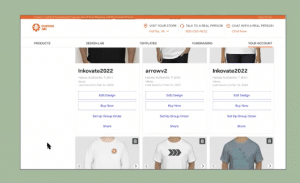
— We had observed that there was an excessive number of stacked buttons on their page
-
Contradicts customer intention to experience

— Abundance of choices ovewhelmed customers, with too many actions
-
Customers were thinking one action would coordinate with others

— The compromised panel reduced conversion for other designs, and started to lose value of serving intended pruposes

— Project was used for UI polish and reducing number of buttons, but team saw need for broader usability issue
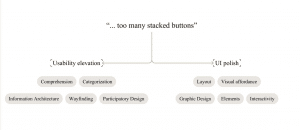
— There was card sorting to improve IA, and facilitate better customer decisions
-
The UX team had a different priority from just visual polish and graphical presentation
-
There was a need for effective wayfinding to engage with an action
-
Card-sort known to facilitate such a process
-

— In UX textbooks, we do have a clear definition of what a card sort is, and what it is most used for

— But let’s look at the underlying language
-
Makes sense to us, but what about a PM who needs to grasp the definitions
-
How can it be translated to business language for the importance of conducting the right activity?
-

— The UX team tried to communicate priorities through a plan for customer interviews and listing out hierarchy in mind
-
But under-estimated impact of three week long plan, which would disrupt engineering sprints
— What wasn’t considered?
-
From the PM’s perspective, a single sprint is hard to find solution, and hard to see what value would be delivered through the product document
-
So what now?

— Our project leader allowed a second pass, and offered two steps
-
Simplifed “card sort’ to arrangement of csutomer needs
-
Card sorting as part of broader research study and impact of decision making

— Evaluation of button arrangement was driven by assessing needs and counter-evaluations that created un-necessary friction and value lay in simple actions for max number of situations
-
Activity represented value discovery

— So reduced number of buttons from six to two, and provided key contextual cues for buying and editing designs

— This led to positive outcome, and resulted in 10% increase in conversion rate

— Recognize importance of going beyond UX-language and clarify value and relevance, with language as tool for meaningful activity

— Two tips I got from this experience
-
Translating UX for others is not betrayal of our discipline.
-
Code-switching is communication tool at the end.

— So reflect on what you will say, and how to express it with a bit more finesse
-
Prototyping and persona to convey a broader meaning

— Emphasize importance of standard language and reduce communication barriers and insist on correct terms when they are used

— Example of tree test, being perceived as a prototype by the product team
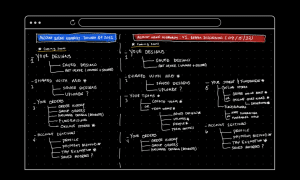
— For context, our team proposed new sitemap for virtual workspaces, and proposed new architecture for various groups in community, including whether people involved in personal or professional capacity
-
Required intuitive navigation system that took account of unique contexts

— First option leveraged existing site architecture and apps to organize info between groups

— Same architecture, and duplicate manual options, and organize into categories for different groups
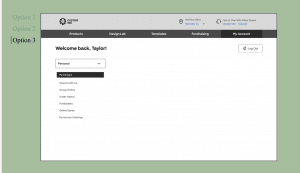
— Listed out all menu options in switchable view through dropdown that applied at site-level

— Between UX and Product, option 2 was hard to scale, so it was discarded

— Between Option 1 and 3, hard to choose which one, and unsure if they would appreciate separation of info in switchable views

— When customers invited to new virtual spaces, they might information that they might not own, but which team might
-
Our concern was that this navigation could cause confusion

— So the product and UX evaluated cons and pros of both options
-
Thought of compromised design of using Option 1 for shared assets and Option 3 for gated assets
-
This abstract proposal would be hard to validate with existing data
— In addition, timeline was tight
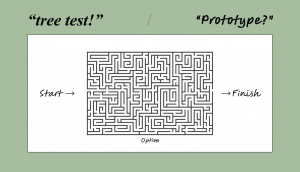
— To initiate process, we conducted a tree test for users to see how they found correct asset with Option 1 and Option 3
-
Could then evalutate for figuring out site structure

— Needed to level-set expectation for what team was reponsible for, and gap between tree test and prototype an
-
Prototype focused on end-solution, while tree-test focused on navigation

— As a result, we observed high success rate for Option 3, and reached agreement on type of artifact responsible for delivering and what not to use
-
This helped us start similar positions

— Tempting to sound new and innovative, and language adds prestige
-
For opportunity to leverage well established language for wider audience, stay with standard for a little longer

— And be willing to teach others user language, as there is a significant overlap in skills, to learn and speak correct language

— So when I shifted from designing for transportaiton, to e-commerce
-
I was shifting my language from safety to growth
-
This allowed me to improve my performance, and gain influence
— Changing a language helps us think like business owner

— Finally, I’ll ask you to notice wheich languages are being used and which ones are not

— And ask if any language has been forgotten?

— And can new language standards surpass what existed in the past?

— Thank you. Any questions?
Q&A
-
Did you something beside card sorts for grasping customer value?
— Yes, broader ongoing studies to look at initiatives, and seeing parallel with different forms for different decision making
-
What tool using to present?
— Used Figjam
-
Evaluate level of effort for hypothetical reward?
— When doing evaluation, evaluate level of effort and what it needs for discovery, to make sure solution and discovery taken into account in a similar way,
-
Successful framing of problem space and what solutions are viable
-
Product people are always budgeting resources and need to measure away potential impact
-
Expecting 10% conversion lift or suprised?
— Yes, part of key metrics we were monitoring
— But in general you want to do something in small scale to get accurate projection on participation
-
Start small and learn as you go
-
Making case for learning other languages, but should we expect PMs to make the same effort for us?
— Good question, and my thinking is not to expect the effort on behalf of the PM, but to still make effort to speak product language
-
Regardless of role played, people will appreciate
-
Be liberal in what you accept, but strict in what you admit
-
Good ways to document translation and clarity of terminology? Playbooks, or glossary?
— Many approaches, but I can recommend training a machine learning model
-
Simplest approach is that of a training doc, and variants introduced into it, and having maintainable way to keep it going
-
Seems like UI polish and usability evaluation require different levels of effort? How do we increase sophistication of UX effort?
— Varies depending on design culture
-
Positive impact on business, take on ownership and sell UX solution
-
Connecting metric to other layers of UX like the information architecture?
— Yes, develop understanding of framework where information architecture will require work relative to visual design, and clearly outlining what would be delivered

